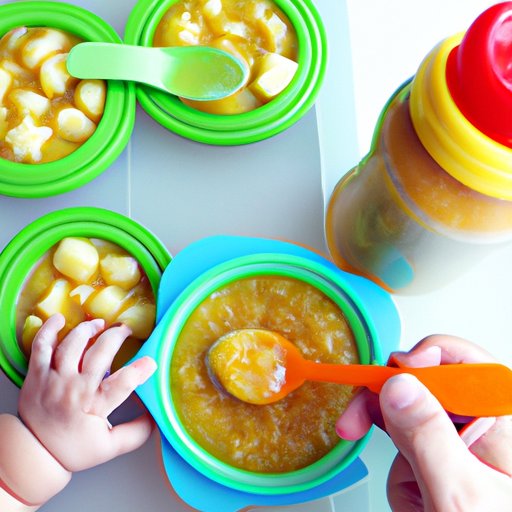Introduction
For new parents, feeding their baby can be an overwhelming experience. It is important to understand the importance of providing your baby with nutritious, healthy food that will help them develop and grow. This article will provide an overview of the steps involved in starting to feed your baby food, from researching the appropriate time to introducing new flavors and textures gradually.
Researching the Appropriate Time to Start Feeding Baby Food
The American Academy of Pediatrics recommends that babies should not be started on solid foods until they are at least 4 months old. This is because their digestive systems are not mature enough to handle anything other than breastmilk or formula. However, there are some signs that may indicate your baby is ready to start solid foods. These include sitting up independently and being able to hold their head in an upright position, showing interest in food by watching what you are eating, being able to move food from a spoon to the back of their mouth, and having doubled their birth weight. Even if your baby shows these signs, it is important to discuss this with your doctor or pediatrician before starting solid foods.

Understanding the Different Types of Baby Food
Once you have discussed with your doctor and decided that your baby is ready to start solid foods, you will need to decide which type of baby food to offer. There are several different forms of baby food available, including purees, mashed food, and finger foods. Purees are most suitable for newborns and babies who are just getting started. Mashed food is more textured, while finger foods are larger pieces of soft food that allow your baby to practice their pincer grip. When choosing baby food, it is important to consider the nutritional content. Babies need a balanced diet that includes iron, zinc, calcium, and other essential vitamins and minerals.

Choosing a Healthy and Nutritious Baby Food
When selecting baby food, it is important to read labels and understand the nutritional content. Look for organic and all-natural options that are free of processed and artificial ingredients. Avoid adding salt, sugar, or honey to your baby’s food. If you are making your own baby food, make sure to use fresh, healthy ingredients. You can also talk to your doctor or pediatrician about any dietary restrictions or allergies that your baby may have.
Preparing the Baby Food According to Directions
Once you have selected a baby food, it is important to follow the instructions on the packaging. Baby food should be heated and cooled according to the directions to ensure the safety of your baby. If you are making your own baby food, make sure to cook it thoroughly and mash or puree it until it is smooth.

Introducing the Baby Food Gradually
Once the food is prepared, it is important to introduce it slowly. Start with one food at a time, offering it every few days so that you can monitor your baby’s reaction. Allow a few days between introducing new foods. As your baby gets used to eating solids, you can start introducing new flavors and textures. Offer a variety of fruits, vegetables, grains, and proteins.
Monitoring Your Baby’s Reaction to the New Foods
As you introduce new foods, it is important to monitor your baby’s reactions. Watch for signs of allergic reactions such as hives, rash, vomiting, or diarrhea. Pay attention to your baby’s appetite and make sure they are enjoying the food. Talk to your doctor or pediatrician if you have any concerns.
Conclusion
Feeding your baby can be a daunting experience, but understanding the right time to start, the different types of baby food, and how to prepare it properly can help make the process easier. Make sure to research the appropriate age for starting solid foods, choose healthy and nutritious options, introduce new foods gradually, and monitor your baby’s reaction. Most importantly, trust your instincts and always consult with your doctor or pediatrician if you have any questions or concerns.
(Note: Is this article not meeting your expectations? Do you have knowledge or insights to share? Unlock new opportunities and expand your reach by joining our authors team. Click Registration to join us and share your expertise with our readers.)
